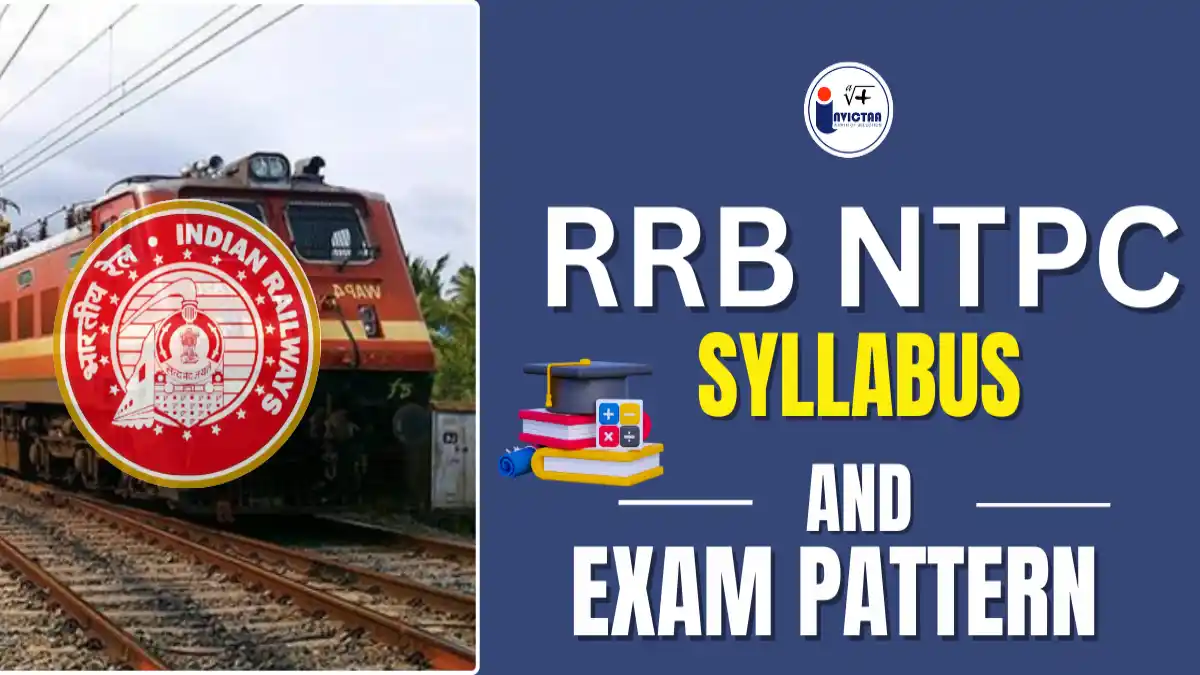The Railway Recruitment Board's (RRB) Non-Technical Popular Categories (NTPC) examination is a multi-stage process for selecting candidates for a wide range of posts. To succeed in this highly competitive exam, a thorough understanding of the detailed exam pattern and the comprehensive syllabus for each stage is the most critical first step.
This guide provides a complete and highly detailed breakdown of the RRB NTPC syllabus and the stage-wise exam structure for 2025. It is designed to help you create a robust and effective preparation strategy by covering every aspect of the examination in detail.
🚀 Download Invictaa Plus App For A Structured Preparation 🚀
RRB NTPC Selection Process & Exam Pattern 2025
The RRB NTPC selection process involves multiple stages, and the stages a candidate must appear for depend on the post they have applied for.
- First Stage CBT (CBT-1): Common for all posts.
- Second Stage CBT (CBT-2): Common for all posts, but with different levels for different post groups.
- Typing Skill Test (TST) / Computer-Based Aptitude Test (CBAT): Required only for specific posts.
- Document Verification (DV) and Medical Examination.
First Stage CBT (CBT-1) Pattern
This is a common screening test for all posts to shortlist candidates for the second stage. The marks from this stage are not used for the final merit list.
| Subject | No. of Questions | Maximum Marks |
|---|---|---|
| Mathematics | 30 | 30 |
| General Intelligence & Reasoning | 30 | 30 |
| General Awareness | 40 | 40 |
| Total | 100 | 100 |
Key Details for CBT-1:
- Negative Marking: 1/3rd of a mark will be deducted for each incorrect answer.
- Total Duration: 90 minutes.
Second Stage CBT (CBT-2) Pattern
This is the main merit-deciding stage. The exam pattern is the same for all levels, but the difficulty of questions varies based on the post level (10+2 or Graduate).
| Subject | No. of Questions | Maximum Marks |
|---|---|---|
| Mathematics | 35 | 35 |
| General Intelligence & Reasoning | 35 | 35 |
| General Awareness | 50 | 50 |
| Total | 120 | 120 |
Key Details for CBT-2:
- Negative Marking: 1/3rd of a mark will be deducted for each incorrect answer.
- Total Duration: 90 minutes.
RRB NTPC Syllabus 2025: In-Depth Topic Breakdown
The syllabus for CBT-1 and CBT-2 is largely the same, but the difficulty level increases in the second stage. Here is a highly detailed, chapter-wise breakdown of the syllabus.
Detailed Topic-wise Syllabus
| Subject | In-Depth Topics & Chapters |
|---|---|
| Mathematics |
The syllabus covers topics up to the 10th standard level, with a higher difficulty in CBT-2.
|
| General Intelligence & Reasoning |
This section tests a candidate's logical and analytical thinking abilities.
|
| General Awareness |
This is a vast section designed to test a candidate's knowledge of current events and general knowledge.
|
(Candidates are advised to download the official syllabus PDF for complete details.)
FAQs: RRB NTPC Syllabus 2025
Q1: Are the marks of CBT-1 counted for the final merit list?
Ans: No, the First Stage CBT (CBT-1) is only a screening examination. Its purpose is to shortlist candidates for the Second Stage CBT. The final merit list is prepared based on the performance in CBT-2 and other applicable skill tests.
Q2: Is the syllabus for CBT-1 and CBT-2 the same?
Ans: Yes, the subjects and broad topics for both CBT-1 and CBT-2 are the same. The main difference lies in the distribution of questions and the difficulty level, which is higher in CBT-2.
Q3: Which posts require a Typing Skill Test?
Ans: The Typing Skill Test is mandatory and qualifying in nature for posts like Senior Clerk cum Typist, Junior Accounts Assistant cum Typist, Senior Time Keeper, Junior Clerk cum Typist, and Accounts Clerk cum Typist.
Q4: Which posts require the Computer-Based Aptitude Test (CBAT)?
Ans: The CBAT is a mandatory qualifying test for candidates who have opted for the posts of Station Master (SM) and Traffic Assistant (TA).
Q5: How is the final merit list for RRB NTPC prepared?
Ans: The final merit list is prepared based on the marks obtained in the Second Stage CBT (CBT-2). For posts with a skill test (TST or CBAT), the candidate must also qualify in those tests. For the posts of SM and TA, 70% weightage is given to CBT-2 marks and 30% to CBAT marks.

